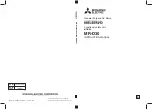
8-14
8-3 Troubleshooting
8
Troubleshooting
The holding
brake is ineffec-
tive.
Power is supplied to the
holding brake.
Check whether power is supplied to
the holding brake.
Configure a circuit that cuts
power to the holding brake
when the motor stops and
the load is held by the hold-
ing brake.
The Servomotor
doesn’t stop or is
hard to stop even
if the RUN
Command Input
(RUN) is turned
OFF while the
Servomotor is ro-
tating.
The load inertia is too
large.
Check the following:
•
Is the load too large?
•
Is the Servomotor speed too
high?
Re-evaluate the load condi-
tions and replace the Servo-
motor/Servo Drive with an
appropriate model if neces-
sary.
The stop circuit failed.
---
Replace the Servo Drive.
The Servomotor
is producing un-
usual noises or
the machine is
vibrating.
(Continued on
next page.)
There are problems with
the machine’s installation.
Check whether the Servomotor’s
mounting screws are loose.
Tighten the mounting
screws.
Check whether the axes are mis-
aligned in the mechanical coupling
system.
Align the mechanical cou-
plings.
Check whether the coupling is un-
balanced.
Adjust the coupling’s bal-
ance.
There is a problem with the
bearings.
Check for noise or vibration around
the bearings.
Contact your OMRON repre-
sentative.
The gain is doesn’t match.
---
•
Use autotuning.
•
Perform manual tuning.
The Speed Feedback Fil-
ter Time Constant (Pn13)
is wrong.
Check the setting of Pn13.
Return the setting to 4 (de-
fault) or increase the setting.
Noise is entering the Con-
trol I/O Cable because the
cable does not meet spec-
ifications.
Check that the cable wire is a twist-
ed-pair wire or shielded twisted-
pair cable with wires of at least
0.08 mm
2
.
Use the Control I/O Cable
that meets specifications.
Noise is entering the Con-
trol I/O Cable because the
cable is longer than the
specified length.
Check the length of the Control I/O
Cable.
Shorten the Control I/O Ca-
ble to 3 m or less.
Noise is entering the cable
because the Encoder Ca-
ble does not meet specifi-
cations.
Check that the cable wires are
twisted-pair wires or shielded twist-
ed-pair wires that are at least
0.12 mm
2
.
Use the Encoder Cable that
meets specifications.
Noise is entering the En-
coder Cable because the
cable is longer than the
specified length.
Check the length of the Encoder
Cable.
Shorten the Encoder Cable
to 20 m or less.
Noise is entering the signal
wires because the Encod-
er Cable is stuck or the
sheath is damaged.
Check whether the Encoder Cable
is damaged.
Correct the Encoder Cable’s
pathway to prevent damage.
Too much noise is entering
the Encoder Cable.
Check whether the Encoder Cable
is tied up in a bundle with or too
close to high current lines.
Lay the Encoder Cable in a
way surges are not applied.
Symptom
Probable cause
Items to check
Countermeasures
Содержание R7D-BP
Страница 18: ......
Страница 26: ......
Страница 138: ......
Страница 176: ......
Страница 238: ......
Страница 264: ......
Страница 290: ......
Страница 310: ......
Страница 311: ...Connection Examples Appendix 1 Appendix...
Страница 321: ......
Страница 324: ......
Страница 326: ......
Страница 327: ......
















































